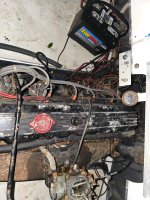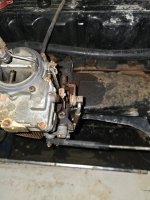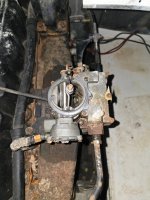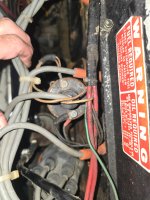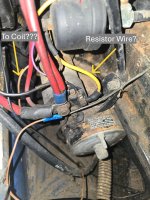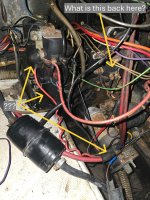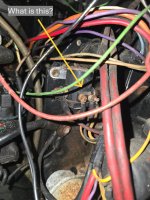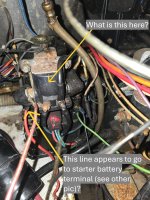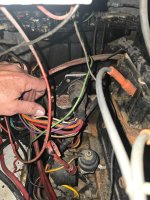I was able to get it started (direct power to coil) and do a compression test. I have never done one before so not sure about results or method.
I am getting 0 Volts with key on at positive side of coil. Also took off the wire and measured directly with no voltage found. I re-checked while cranking with test light and saw some light. So I continued, bypassed points and got spark from coil after replacing coil wire (broke when I tried to pull it off - corroded - rigged and will need replacing).
Cleaned points and distributor - all which looked pretty good overall (points really needed cleaning though). I wasn't having any luck so I tried 12V direct to coil and it started trying to run... So I continued trying to start and it ran. I got a video of it the second time (lower unit is on hose) ...
It sounds terrible and the starter may even have remained cranking for some reason.
For compression I used my 5+ year old (still new in package) Harbor Freight tester. Hand tight in the plug holes (no oil applied to cylinders) and given 3-4 cranks (a few revs per crank) the numbers came out like this:
#1 - 103
#2 - 108
#3 - 125
#4 - 102
#5 - 105
#6 - 113
I need to figure out where the disconnect is from the ignition/key on to the coil. As Spare said I want to be careful with the points. If the compression sounds good for a first go I'll continue. What do you think of the compression numbers? Online I see a wide range of answers.
Broke a plug (way too easily) trying to get it out so I'll probably get new plugs and order a new coil wire (or a whole set). Change the oil (it seems really runny to me) with some SAE 30 and new filter. I might soak the cylinders in some oil overnight or two (I bought some Marvelous Mystery Oil for this purpose already).
The lower unit had been greased before I picked up the boat. I suppose the next thing would be to drain and fill the oil in lower unit. I'd like to determine if it is pumping water. Remove a hose?
Previously I had pulled the lower unit drain plug and @ few tablespoons of clear water came out. I couldn't remember if it was before or after I had first tried to start on the hose.
Questions:
Is the impeller moving any time the engine is rotating? For instance, during start. Anytime I crank the motor (even no start) should I be on the hose?
Where can I get the drain plug gaskets for the lower unit fill, vent, and trim unit? They all look same size. They are black plastic, flat ones.
Any tips on tracking down the issue from ignition power? I tried seeing if any of the plug tips had power when the key was on but didn't see anything there.
I don't seem to have a yellow resistor wire to the coil. Could I have an internally resisted coil that would be ok for 12V at coil? I see the two joined wires at the coil that are probably 12V + Run/ignition (NOT WORKING) and 12V + from solenoid.
Thanks!!
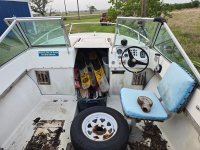 20250418_185733.jpg2.2 MB · Views: 23
20250418_185733.jpg2.2 MB · Views: 23 20250418_185723.jpg2.1 MB · Views: 21
20250418_185723.jpg2.1 MB · Views: 21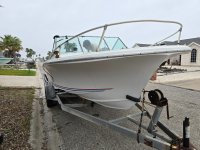 20250419_153235.jpg1.9 MB · Views: 21
20250419_153235.jpg1.9 MB · Views: 21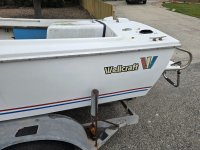 20250419_153251.jpg1.8 MB · Views: 19
20250419_153251.jpg1.8 MB · Views: 19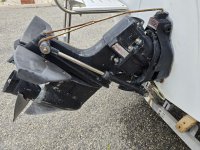 20250419_153322.jpg2.3 MB · Views: 18
20250419_153322.jpg2.3 MB · Views: 18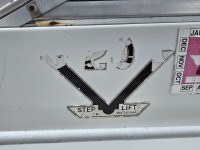 20250419_153337.jpg1.3 MB · Views: 19
20250419_153337.jpg1.3 MB · Views: 19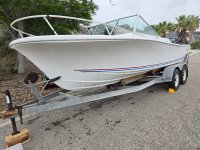 20250419_153542.jpg3.1 MB · Views: 18
20250419_153542.jpg3.1 MB · Views: 18 20250419_153931.jpg2.3 MB · Views: 22
20250419_153931.jpg2.3 MB · Views: 22
